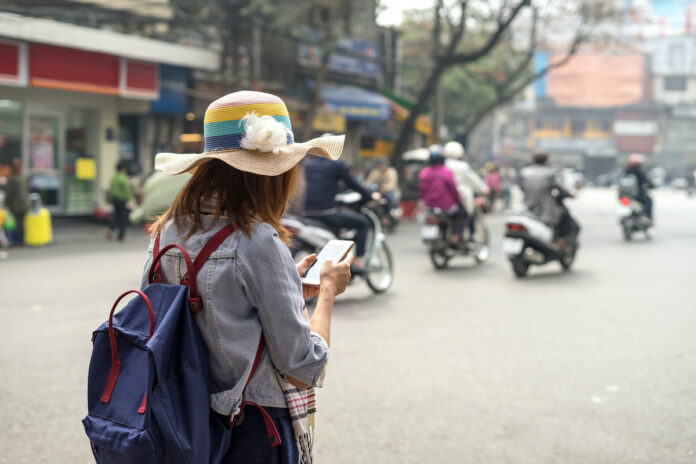When we got married over 40 years ago, the internet didn’t exist, and smartphones were confined to the realm of science fiction. So when we traveled, we had to rely on paper maps and guidebooks specific to our destinations.
Over the intervening years, smartphones have become part of our reality, and have evolved into indispensable travel tools upon which we rely for trip planning, destination details, booking accommodations, and spur-of-the-moment changes in the itinerary based on changing circumstances.
Today, there are so many clever and useful smartphone apps that it’s impossible to cover all the ones we use — so we’ll share some of our favorite and most utilized apps. We work exclusively with Apple devices because of their instant accessibility for people who are blind and vision impaired. Many of the apps we mention here are available for Android devices, but we’re not familiar with apps for this platform.
1. Travel Smart
When we travel overseas, we need to know that if we require medical attention we have adequate health insurance. We purchase an annual plan from Allianz that covers both of us. Claims that we have had to submit have been handled efficiently.
2. AirMed
Fortunately, we’ve never needed medical evacuation, but we have a friend that used the service of AirMed when his wife fractured a hip in Costa Rica. AirMed handled everything involved in a transfer to a hospital in the U.S.
3. SmartTraveler
SmartTraveler from the U.S. State Department is an essential app we consult before overseas travel, and sometimes while on the move, since it provides critical information on visas, safety and security, local laws, and how to contact the closest embassy or consulate in an emergency.
Pro Tip: You can use this app to confirm you can legally carry your medication (even prescription medication) to the countries you are visiting.
4. Waze
Many rental cars today have onboard navigation systems. The problem is that each brand of vehicle is different and may be awkward to program, particularly if you have to use your non-dominant hand to type on the screen. When renting cars in Europe, the navigation system is set up in the native language, so we rely exclusively on a smartphone for navigation.
Our app of choice is Waze, which actually uses Google maps as its base, but is crowdsourced for changes in road conditions in real time. A downside is if you lose cell signal, you also lose mapping capability.
Pro Tip: When traveling outside the U.S., it’s best to change out your SIM card for a local one. Using your U.S. SIM card in another country could be costly.
5. Rome2Rio
With Rome2Rio, you enter a starting point and a destination, and the app provides recommendations on different forms of transport that connect the two locations. For example, we were in Sicily on the night we learned Italy was closing its borders due to COVID. We used Rome2Rio to look at outbound destinations around Europe and to identify the airlines serving each city and the range of prices to expect.
Pro Tip: Download apps for the airlines you might use on your trip. They definitely helped during our evacuation from Italy by enabling us to consult several budget airlines flying from Sicily.
6. FlixBus
Moving between countries In Europe, we frequently travel overland because it is often less expensive than flying and you get to see the changing countryside en route. One-way car rentals are not practical, so we’ve used FlixBus because of their extensive network and reliability.
7. Trainline
We use trains much less than buses, but when we have chosen this mode of transport we have used Trainline to find schedules and approximate pricing. A reservation can also be completed using this app, but we prefer to go to the station to confirm schedules, pricing, and the need to reserve seats.
Pro Tip: We add subway and/or local bus apps as we travel to new cities.
8. Booking.com
We make many of our lodging arrangements through Booking.com prior to departure, but sometimes plans are more fluid, or we need to make last-minute changes. An example is being unable to negotiate several flights of stairs with a broken ankle.
Pro Tip: Sometimes we look for alternative arrangements using hotels.com, Airbnb, and Hotel Tonight.
9. NPS App
If you are a devotee of the National Park System in the U.S., they have a great app (NPS) where you can get information about many, if not all, national parks. We use this app to search for information by several different criteria including state and facilities available. Beyond providing basic information, there are self-guided tours for many sites.
10. Rick Steve’s Europe
This app has an extensive list of self-guided walking tours in cities and towns throughout Europe. We’ve used them in Florence and Venice and have really appreciated the detail provided.
11. Get Your Guide
The Get Your Guide app is a great source for finding guides that fit the type of walking or driving tour you are seeking. Each sets their own itinerary and the associated cost.
Pro Tip: Many cities are now developing their own walking or driving apps showcasing the highlights of their downtown or suburban areas. The VisitJax app for Jacksonville, Florida is just one example. Check with the local tourist office website to see whether your chosen city has an app.
12. XE
When traveling outside the U.S., it’s important to understand how much things cost, so having an app that will do currency conversion is essential. We use XE to help with this, but because of exchange rates and fees, the ultimate amount you pay may vary slightly from other currency conversion apps.
Pro Tip: Download apps for each of your credit cards and your bank to track charges and if necessary, pay bills online.
13. Global Tips
Tipping customs vary in different countries so. We use this app to ensure we fit in with local customs as much as possible.
14. NordVPN
We strongly advise against using any public Wi-Fi, especially when doing financial transactions. Using your phone’s data plan is far more secure. For an added level of security, we highly recommend using a virtual private network (VPN) app that anonymizes your connection and significantly reduces the risk of being hacked. There are free VPN apps, but we use NordVPN, a subscription that allows multiple devices for a single price.
15. Speak And Translate
When traveling, the ability to communicate is essential, but there are times when you won’t find someone who speaks any of the languages you know. When we were in China, the concept of using a translation app was introduced to us by a hotel clerk. You select your native tongue and the language of the other party then you ask your question verbally into the app and it provides immediate translation both verbally and in the local script.
Pro Tip: We also used Google Translate in China to crosscheck translations.
16. WhatsApp
To be able to communicate with friends and family while on international travel we use WhatsApp as an effective tool for video calls, voice calls, and texts using Wi-Fi and/or our data plan. The other party must also have the app on their smartphone.
Pro Tip: The time to test how it works is before you leave home.
Unlock the world’s wonders with unforgettable journeys tailored just for you! Whether you crave sun-kissed beaches, thrilling adventures, or rich cultural escapes, your dream destination awaits. Enjoy seamless travel with expert tips, exclusive deals, and handpicked experiences that Turn Every Trip into a lifetime memory.










